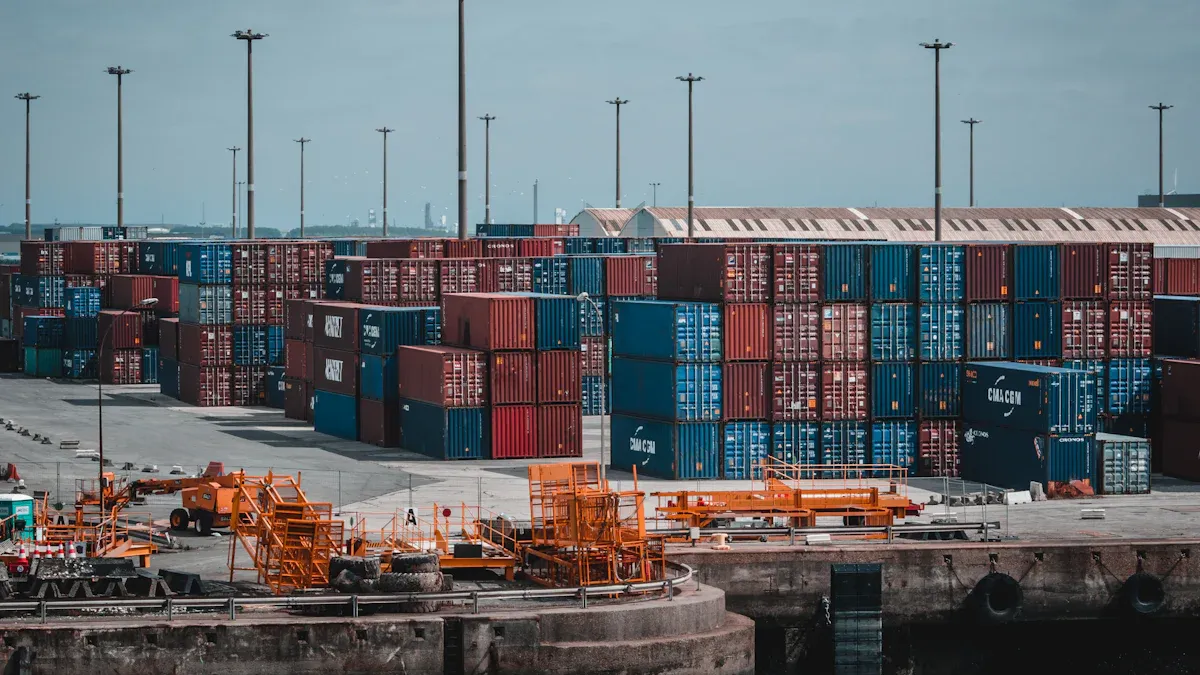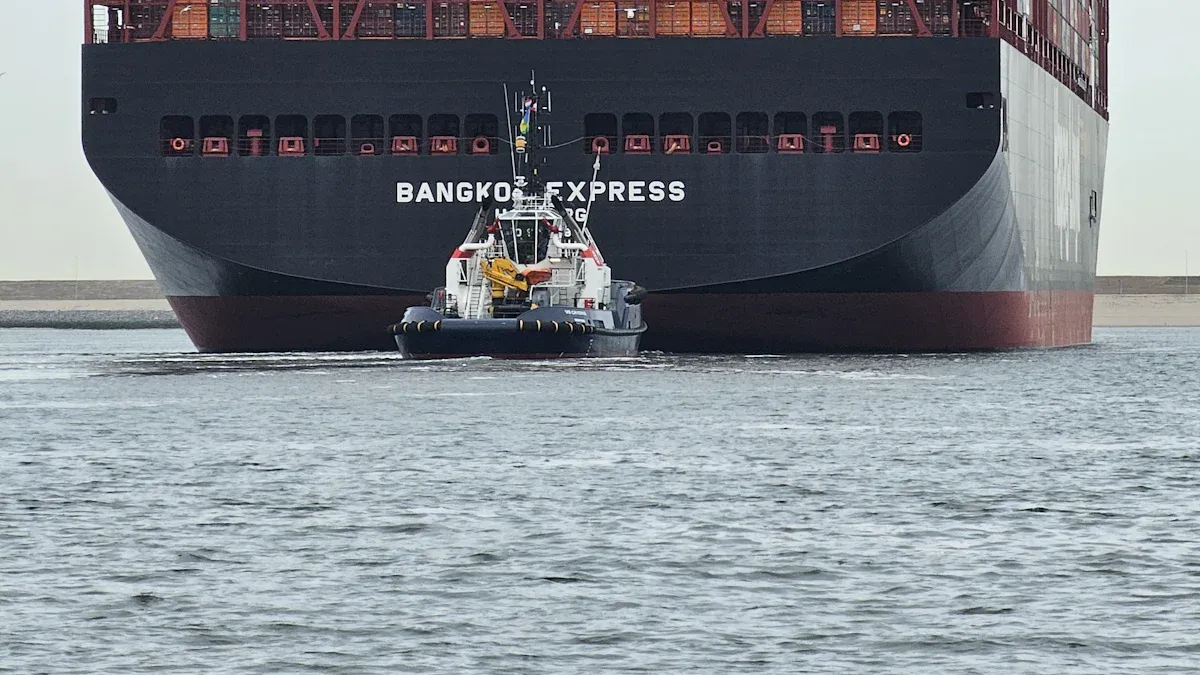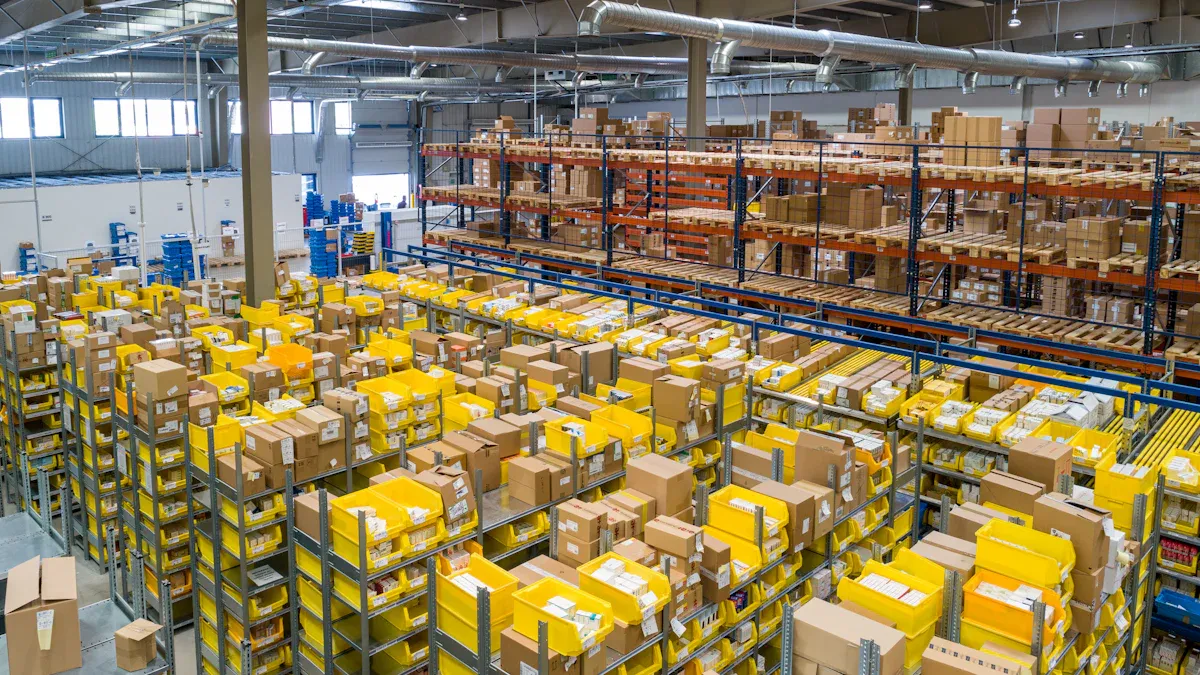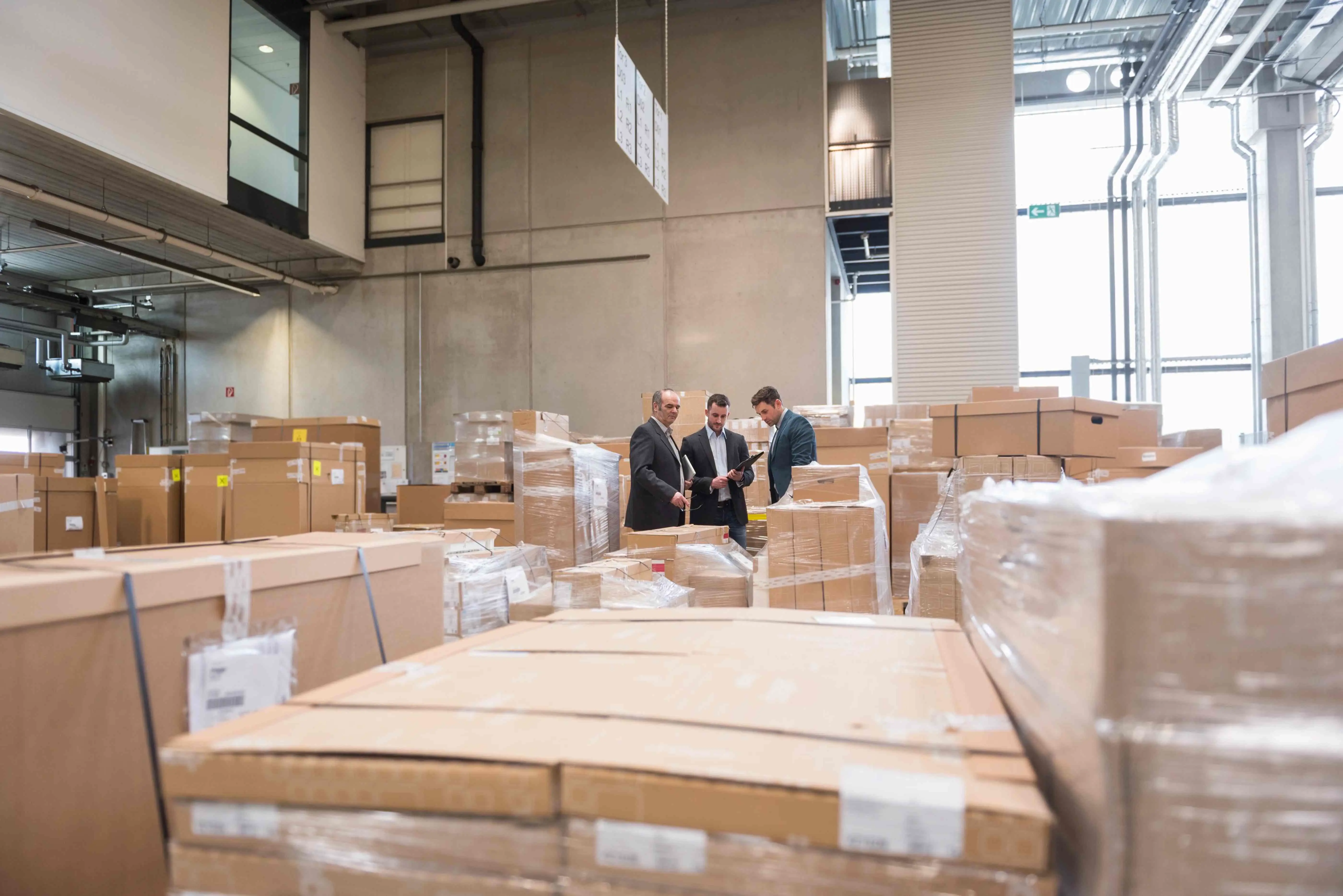Revolutionizing International Logistics Warehousing to Tackle 2025 Challenges

The logistics field is changing fast due to global trade and technology. By 2024, it will be worth $5.65 trillion. By 2033, it may grow to $8.07 trillion. This shows how tricky international logistics warehousing is becoming. Companies like JUSDA are creating smart ideas to solve these problems.
Key Takeaways
Higher logistics costs push companies to use machines and hire outside help to save money and compete better.
Fewer workers in logistics can be managed by using machines for easy jobs, making work faster and needing fewer people.
Green warehouse methods help nature, save money, and make suppliers work better.
Key Challenges in International Logistics for 2025
Rising Costs and Their Impact on Warehousing
Running warehouses is getting more expensive for businesses. Costs are rising because rents, worker wages, and other expenses keep going up. Energy costs might stay steady, but labor and rent will still increase. This makes it harder for companies to manage their budgets. To save money, many businesses are using more machines or hiring outside help.
New rules and taxes make things worse by raising shipping costs. Planning logistics becomes harder too. As trade changes, companies must handle these money problems while staying efficient and competitive.
Labor Shortages in the Logistics Sector
Finding workers is a big problem in logistics. In the U.S., there are about 450,000 open jobs in transportation and warehousing. Many companies struggle to find enough workers for tasks like shipping, storing goods, and managing inventory.
Keeping skilled workers is tough, which slows down operations. To fix this, over half of companies are using machines to do simple tasks. This helps them work faster and need fewer workers. Still, not having enough workers hurts customer service, profits, and supply chains.
Sustainability Demands in Warehousing
Making warehouses eco-friendly is now very important. Warehouses cause about 11% of pollution from logistics. Research shows four key ideas for greener warehouses, like better locations and eco-friendly practices.
Evidence Type | Description |
|---|---|
Emissions Contribution | Warehouses cause about 11% of logistics-related pollution. |
Research Themes | Four ideas for greener warehouses, including better locations. |
Research Recommendations | Twelve tips tied to global goals for greener warehouses. |
Using green methods helps the planet and makes warehouses run better. Companies are spending on eco-friendly tools and choosing better spots for warehouses to cut pollution and follow rules.
Supply Chain Disruptions and Resilience Challenges
Supply chains are breaking down more often and costing more money. For example, a chip shortage during COVID-19 caused $110 billion in losses by mid-2021. These problems raise costs for materials and shipping, hurting profits.
Now, companies are working to make supply chains stronger. They are using more suppliers, tracking goods in real-time, and improving inventory systems. These steps help reduce risks and keep operations running smoothly.
Cybersecurity Concerns in International Logistics
Using more digital tools in logistics has increased cyber risks. In three months, hackers ran 9,024 phishing scams targeting logistics. Also, 124 ransomware attacks hit the industry, making up 10.9% of all cases.
These attacks stop work, steal data, and hurt customer trust. To fight this, companies are spending on better cybersecurity. They use strong encryption, train workers, and watch for threats in real-time. Protecting digital systems is key to keeping global supply chains safe.
Opportunities in International Logistics Warehousing

Automation and Robotics in Warehousing
Automation and robots are changing how warehouses work. They help save money and make tasks faster. Machines handle jobs like sorting, picking, and packing. This makes warehouses quicker and more accurate. By 2025, 45% of factories will use robots.
The market for warehouse machines will grow to $29.91 billion by 2025. It will keep growing at 16.2% each year until 2030. These tools mean less need for workers and fewer mistakes. Companies using automation can work better and meet global demands.
AI-Driven Inventory Management Solutions
AI is helping businesses manage their stock better. It predicts what items are needed and gives real-time updates. For example, Rolls-Royce used AI to manage spare parts, cutting delays. H&M used AI to guess demand and save money on extra stock. Tesco used AI to handle over 100,000 items, reducing waste.
These examples show how AI helps businesses make smarter choices. It reduces mistakes and keeps stock levels right. This means happier customers and lower costs.
Sustainable Warehousing Practices for 2025
Eco-friendly methods are now key in warehousing. Companies are working to cut pollution and meet global green goals. Studies show these results:
Outcome Type | Measurable Impact |
|---|---|
Emission Reductions | Carbon footprints dropped by 25-40% in 5 years |
Cost Savings | Logistics costs fell by 15-20% |
Waste Elimination | Packaging waste cut by 30-60% |
Supplier Performance | 40-70% of suppliers met green standards |
These green steps help the planet and save money. Companies also meet rules and improve supplier work. It’s good for both business and the environment.
Strategic Warehouse Placement and Network Optimization
Where warehouses are placed matters a lot. Good locations cut transport costs and speed up deliveries. Data shows these benefits:
Benefit | Description |
|---|---|
Reduced Transportation Costs | Central spots lower travel costs for goods. |
Shorter Delivery Times | Being close to customers means faster deliveries. |
Improved Customer Satisfaction | Quick shipping makes customers happy and loyal. |
Placing warehouses smartly helps companies save money and deliver better service. It keeps them ahead in the global market.
Leveraging JUSDA’s China-Europe Express Rail for Efficiency
JUSDA’s China-Europe Express Rail is a smart logistics solution. It’s faster than ships and cheaper than planes. Goods take 15-20 days to travel across continents.
This rail service carries many items like electronics and clothes. JUSDA handles customs well, avoiding delays. It also connects to Southeast Asia using sea and rail.
Using this service helps businesses save time and money. It’s a great way to handle 2025’s logistics challenges.
Case Studies and Examples
Real-World Example: Automation in Warehousing
Automation has changed how warehouses work by making them faster. Real examples show its benefits:
Example | Results | Key Numbers |
|---|---|---|
Faster Order Processing | Orders handled 15% quicker | Processing times improved and became more consistent |
Lower Fuel Costs | Saved 10% on fuel each year | Big differences in fuel use across vehicle groups |
Quicker Deliveries | Delivery times cut by 12% | Regional routes showed faster delivery times |
Better Technology Use | Fewer delays and better tracking | Big improvements after adding new technology |
These changes help solve problems and make supply chains stronger. Companies using automation save money, work faster, and improve logistics.
Hypothetical Scenario: AI-Optimized Inventory Management
AI tools can help fix inventory problems. Imaginary examples show their benefits:
AI Tool | How It Helps |
|---|---|
Forecasting Systems | Predicts demand using real-time stock updates |
Digital Twins | Tests ideas without disrupting real operations |
Simulations | Finds ways to improve logistics networks |
These tools help businesses plan better, keep the right stock, and work smoothly. AI makes supply chains stronger and ready for changes.
Case Study: JUSDA’s Green Warehousing Initiatives
JUSDA leads in eco-friendly warehouse practices. Their green ideas cut pollution, save money, and reduce waste. For example, JUSDA’s warehouses lowered carbon footprints by 25-40% in five years. Costs dropped by 15-20%, and packaging waste fell by 30-60%. Suppliers improved too, with 40-70% meeting green goals. JUSDA shows how companies can help the planet while working better.
Success Story: China-Europe Express Rail in Action
JUSDA’s rail service boosts trade between continents. Routes outside the top ten grew from 31% in 2020 to 44% in 2021. A new consignment notice in 2017 sped up deliveries and border checks. Key routes now take just 5.82 days in transit. JUSDA’s rail system shows how smart ideas can solve problems and strengthen supply chains worldwide.
Future Trends and Recommendations

Emerging Technologies in Warehousing: Robotics and Digital Twins
Warehouses are changing with robotics and digital twins. These tools make work faster and smarter.
Advanced AI Integration: AI studies live data to improve warehouse tasks.
Edge Computing: It handles data quickly for faster decisions.
Robotics Testing: Digital twins create fake spaces to test robots safely.
“Smart warehousing uses connected and automated tools to make work easier.”
Technology Trend | Description |
|---|---|
AI helps warehouses make better choices and work faster. | |
Real-Time Data Processing | Edge computing speeds up data handling for quick actions. |
Robotics and Automation Integration | Digital twins test robots in virtual spaces to boost efficiency. |
These tools help companies stay strong during tough times in global logistics.
The Rise of Green Warehousing Practices
Green warehouses are becoming popular as businesses focus on the planet. They use less energy and cut pollution. Studies show how checking energy use and emissions can help.
Companies are using eco-friendly designs and solar power.
Research highlights the importance of green goals in warehouse planning.
These ideas save money, meet rules, and help the environment.
Actionable Recommendations for Businesses in 2025
To handle future logistics, companies need smart plans. Here’s what they should do:
Recommendation | Description |
|---|---|
Have backup shipping options to avoid delays during problems. | |
Embrace Cutting-Edge Technology | Use AI and IoT to manage stock and predict needs. |
Diversify Sourcing & Fulfillment | Work with many suppliers to avoid risks from trade issues. |
Keep Liquidity in Your Business | Save money to handle surprise costs and meet customer needs. |
These tips will help businesses stay strong and succeed.
JUSDA’s Vision for the Future of International Logistics
JUSDA sees a future where logistics is easy, fast, and green. Using AI, robotics, and digital twins, JUSDA wants to improve supply chains. Their focus on green warehouses and smart ideas like the China-Europe Express Rail makes them a leader in solving global logistics problems.
JUSDA’s plans for resilience and eco-friendly solutions will help businesses keep up with changes in logistics for 2025 and beyond.

JUSDA Solutions
To provide you with professional solutions and quotations.
The international logistics world in 2025 has problems and chances to grow. Companies deal with issues like broken supply chains, changing needs, and strict rules. But there are also chances to expand, save money, and go green.
Opportunities | Challenges |
|---|---|
Growing into New Markets | Problems in certain regions |
Working Faster and Smarter | Supply chain troubles |
Cutting Costs | Following strict rules |
Staying Ahead of Competitors | Weak infrastructure |
Stronger Supply Chains | Changing customer needs |
Eco-Friendly Projects | Tough environmental rules |
Smart planning and new ideas are key to solving these problems. JUSDA’s tools, like the China-Europe Express Rail, make shipping faster and more reliable. By using these tools, companies can handle tough times and succeed in global logistics.
See Also
Transforming Logistics: The Future of AI Supply Chains
Discovering 2024 Innovations in Sea Freight Logistics
Supply Chain Innovations: Redefining the Future of Logistics
Digital Technology: Shaping the Future of Logistics
Boosting Warehouse Efficiency with Advanced Logistics Robotics
